In this edition of Clash of Segments, we have a very interesting comparison between one of the most affordable compact SUVs in the country and one of the most feature-packed and luxurious premium hatchbacks in the country. Yes, we are talking about the Renault Kiger and Hyundai i20. It is the classic case of one trying to enter into the other’s territory. While customers on a budget are going for the SUV and some people with a budget of an SUV are compelled to buy the i20. Both these products have very specific characteristics and features which make a strong case for both. However, you need to know what you want from your car and this post will help you figure out the better option for you considering factors like the looks, features, prices, powertrains and safety. If you are interested in more comparison posts, make sure to follow the Comparisons/Features Section at Car Blog India. Let us get into the comparison.
Also read: Renault Kiger vs Hyundai Venue – Engines, Features, Specs, Safety, Price Comparison!
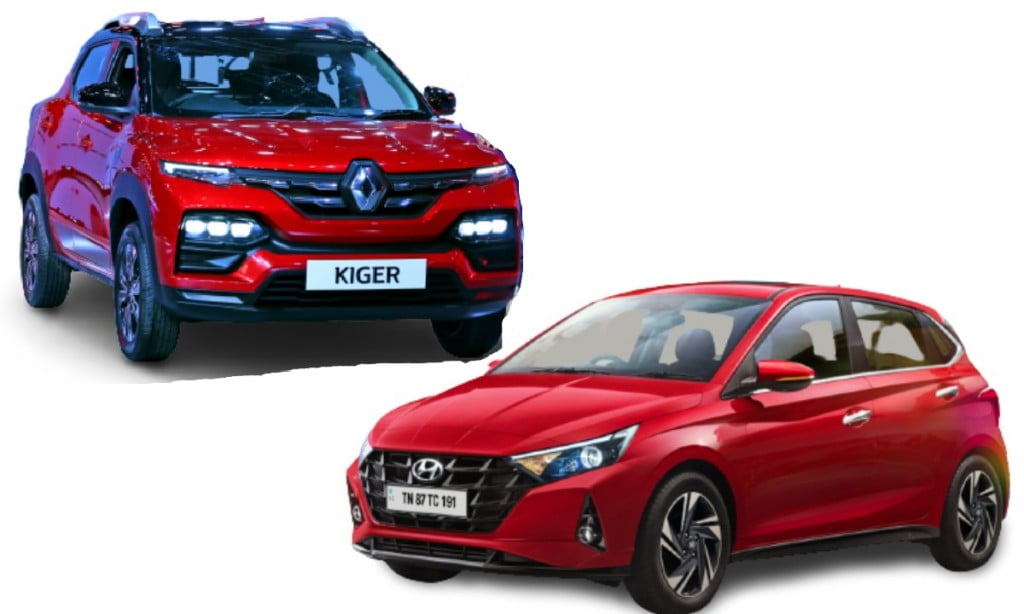
Hyundai i20 vs Renault Kiger – Exteriors and Dimensions
Hyundai has always made sure that the i20 badge keeps on breaking the stereotypes in terms of exterior design and this version of the i20 is no different. The 3rd gen i20 is sure to make heads turn everywhere you go with its bold characteristic creases on the front, along with the Parametric jewel pattern grille. The LED Projector Headlamps and LED DRLs additionally, enhances the front look and make it look bolder and wider. The chrome on the window rims also gives the side profile a modern and flashy look. The Z-shaped tail lamps, joined by a chrome strip are extremely sporty but could be polarising. The puddle lamps and chrome outside door handles do make it look premium. The stylish alloy wheels contribute to the overall bold and modern design of the premium hatchback.
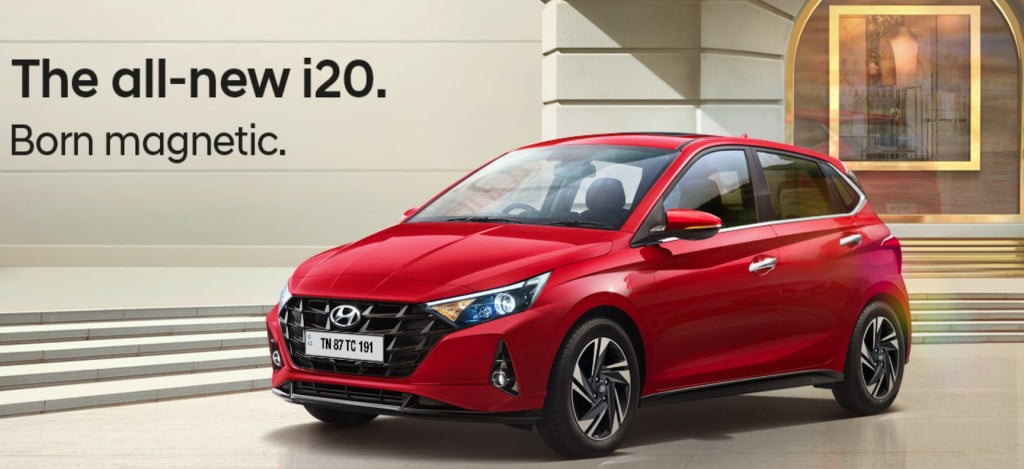
Being a modern car, the Kiger also sports some modern design elements. This includes two honeycomb-shaped chrome effects running across the front grille and LED DRLs placed on the bonnet. The LED headlamp cluster is placed down below on the bumper, which is encased in the chrome unit. Along with this, the sporty front bumper with skid plates gives it a tall and muscular stance. The sides are accentuated by the 16-inch black diamond-cut finished alloys, wheel arch cladding with roof rails and dual-tone roof. When we move to the rear, we are greeted by the LED tail lamp unit with glossy black inserts, which make the look very modern indeed.
Also read: Renault Kiger vs Kia Sonet – Engines, Specs, Features, Prices, Safety Comparison!
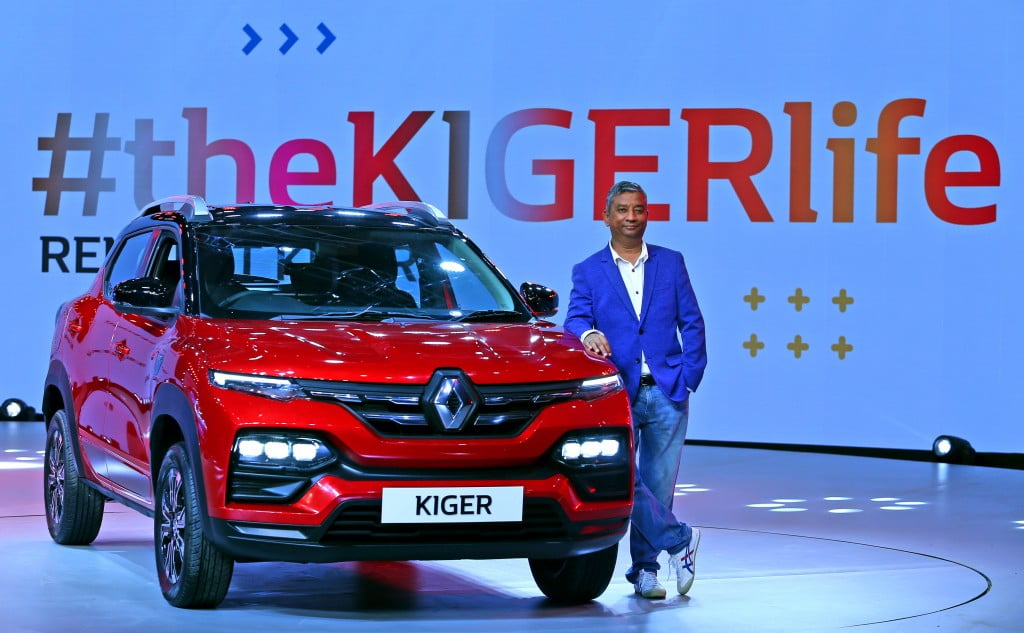
| Parameter | Hyundai i20 | Renault Kiger |
| Length (mm) | 3995 | 3991 |
| Width (mm) | 1775 | 1750 |
| Height (mm) | 1505 | 1600 (with roofrails) |
| Wheelbase (mm) | 2580 | 2500 |
| Boot Space (l) | 311 | 405 |
The dimensions of these cars are not too different from one another which is unique because this two belong to two completely different segments altogether. While the Hyundai i20 is longer and wider than the Renault Kiger and also has a longer wheelbase making the space for the passengers usable, the Kiger is a bit higher and has a much bigger boot space. Both these cars are competitively stacked up against each other in this aspect.
Also read: Maruti Suzuki Vitara Brezza vs Renault Kiger – Engines, Features, Specs, Safety, Price Comparison!
Hyundai i20 vs Renault Kiger – Interiors, Features and Safety
The Hyundai i20 is arguably the most extensively feature-packed product in the premium hatchback segment. The 10.25-inch Touchscreen Infotainment System comes equipped with Apple CarPlay and Android Auto along with Hyundai’s own Connected Car Tech with Bluelink App and wireless charging. There is an air purifier incorporated in the centre console between the two seats. Another segment first is the Bose 7-Speaker Audio System with a subwoofer. For the love of Sunroofs in India, Hyundai has made sure that this premium hatchback comes with an electric sunroof as well. Other features include Ambient lighting, Automatic climate control, Cruise Control, Rear AC Vents, Leatherette Upholstery, Cooled Glovebox and Keyless Entry and Go. On the safety front, the 3rd Gen i20 gets equipped with 6 airbags, ABS, ESC, Rear View Camera and segment firsts: Tyre Pressure Monitoring System and Hill Start Assist. The Digital Instrument Cluster and the steering wheel have been imported from the higher segment Hyundais like the Verna and the Creta.
Also read: Maruti Suzuki Ciaz vs Skoda Rapid – Engines, Prices, Specs, Features Comparison!
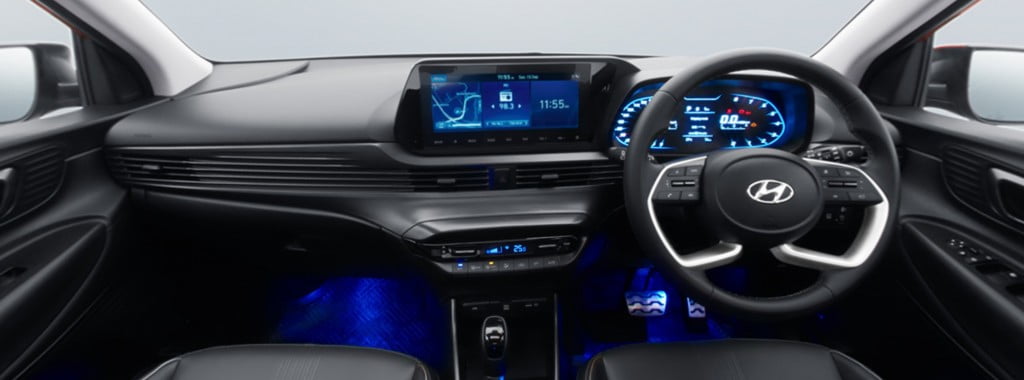
Being the latest launch in the segment, the interiors of the Kiger revolve around the 8-inch Digital Infotainment Touchscreen with wireless smartphone replication for Apple CarPlay and Android Auto with Voice Recognition, USB and Bluetooth connectivity for seamless pairing of smartphones to use the driving and multimedia apps. Through the MULTI-SENSE setup, the drive can choose from various driving modes according to the conditions, like Normal, Eco and Sports mode. All this information is available to the driver via a 7-inch TFT Digital Instrument Cluster. Then there is the Auditorium 3D Sound system with 8 speakers, Ambient Lighting, Hands-free smart access card, Automatic Climate Control, Air Filter and much more. On the safety front, the Kiger comes equipped with dual-front airbags as well as two side airbags, Radar Sensors and Reverse Parking Camera, front seats get seat belt reminder alert, ABS with EBD, Three-point seatbelts for front and rear passengers (rear center passenger gets a two-point seatbelt).
Also read: Main Components of a 4-stroke IC Engine – Pistons, Valves, Turbo, Camshafts and more!
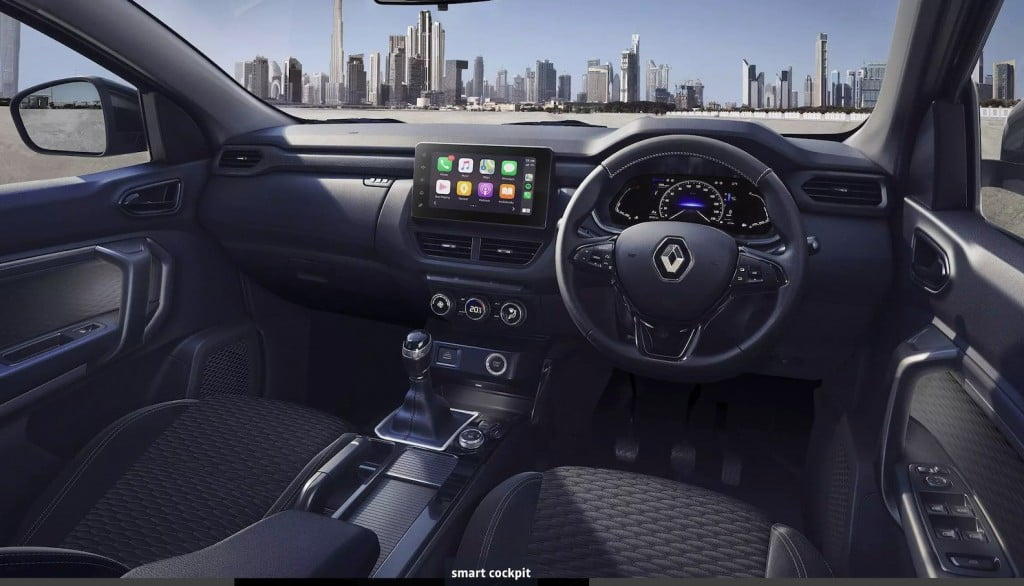
Hyundai i20 vs Renault Kiger – Powertrains, Transmissions and Prices
The Hyundai i20 comes with a plethora of engine options from a 1.2-litre naturally aspirated petrol making 82hp and 114Nm, a 1.5-litre diesel making 100PS and 240Nm and a new 1.0-litre turbo petrol making 120PS and 171Nm. These engines can be combined with manual, CVT, iMT and DCT transmission options. With this particular launch, however, Hyundai has gone into a league of their own with prices ranging between Rs 6.85 lakh and Rs 11.34 lakh, ex-showroom. Hyundai i20 is expensive without a doubt, but with this extra money, you do get a ton of more features and engine options to choose from.
Also read: Hyundai launches teaser of the upcoming 7-seat SUV, Alcazar – Launch in June 2021!
The Renault Kiger comes with only a petrol-powered engine option in two states of tune. There is a 1.0-litre naturally aspirated unit making 71 hp and 96 Nm and a 1.0-litre turbo petrol unit making 99 hp and 160 Nm. These engines can be mated to a 5-speed manual, 5-speed AMT or a CVT automatic transmission. The prices of the Renault Kiger start at Rs 5.64 lakh and go all the way up to Rs 10.08 lakh, ex-showroom.
Also read: 6 Most Relevant Connected Car Tech Features in Modern Cars!
Hyundai i20 vs Renault Kiger – Verdict
With two products which are so distinct in characteristics and heritage, it is not an easy decision to choose one. But as we had promised, we will help you make a decision according to your needs and requirements. Now, if your budget and practicality are your priorities, then a product like the Kiger makes a lot of sense for you. It has all the basic features, a ton of boot space and a bit of ruggedness inherited in its SUV DNA. Also, it comes a whole lot cheaper than the i20 in its top trim. On the other hand, if you are someone who wants to indulge yourself in a bit of luxury with premium features and powerful engines making for a better driving thrill and money is not a big concern for you, then you can definitely opt for the Hyundai i20.
Also read: Upcoming Cars and SUVs in 2021 – Rapid, Kushaq, Taigun, HBX, XUV700 and more!

